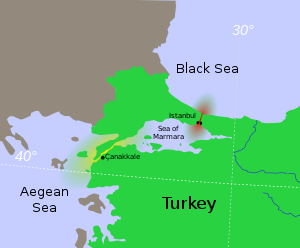Montreux Convention
The Montreux Convention Regarding the Straits Regime, or simply the Montreux Convention, is an international treaty that governs Turkey’s Bosporus and Dardanelles Straits.
Overview:
- It was signed on July 20, 1936, in the Montreux Palace in Switzerland, and took effect on November 9, 1936.
- This convention was signed to address the long-running Straits Question of who should manage the strategically important route between the Black and Mediterranean Seas.
- The maritime traffic through the Black Sea is regulated by the Montreux Convention.
- During peacetime, it grants full freedom of passage for all civilian vessels and allows Turkey to limit the movement of navies who do not belong to the Black Sea states.
- During wars, this pact gives Turkey the right to regulate the naval warship transits and blocking of the strait for warships of the countries in conflict.
- Military warships are restricted in terms of tonnage, number, and weaponry, with specific rules that govern their duration of stay and mode of entry.
- Advanced notifications have to be provided by warships to the Turkish authorities, who then must notify the parties to the Convention.
- Despite being created for a specific geopolitical context, the Montreux Convention is still in force and is a strong example of a rules-based international order since most of its terms are still respected.
- Controversies did happen regarding its implementation, most notably during the proposed Kanal Istanbul. Another waterway would be provided by Kanal Istanbul to the Sea of Marmara from the Black Sea, and this could lead to circumventing the Convention.
Implementation of the Montreux Convention
The provisions of the Convention reflected the world situation in the mid-1930s to a great extent. They primarily benefited the Turks and Soviets by allowing Turkey to reclaim military control of the Straits and ensuring Soviet control of the Black Sea. Although the Convention limited the Soviet Union’s ability to send naval forces into the Mediterranean Sea, it also ensured that outside powers could not use the Straits to threaten the Soviet Union.
Russia-Ukraine Crisis
Following Russia’s invasion of Ukraine, the Ukrainian government requested that Turkey use its authority under the Montreux Convention to restrict Russian vessels’ movement from the Mediterranean to the Black Sea. At least six Russian warships and a submarine passed through this strait. After some reluctance, due to Turkey’s close ties with both belligerents, Turkey’s Foreign Minister Mevlüt Çavuşoğlu announced that the government would officially recognise the Russian invasion as war allowing the Convention to be implemented with respect to military vessels. However, Turkey cannot prevent Russian warships from returning to their registered base under the rules of the agreement.
About Bosporus and Dardanelles Straits
The Bosporus and Dardanelles straits, often known as the Turkish Straits or the Black Sea Straits, connect the Black and Aegean through the Sea of Marmara. It is the only way for Black Sea ports to reach the Mediterranean and further beyond. Every day, about three million barrels of oil, pass through this canal, the majority of which is produced in Russia, Azerbaijan, and Kazakhstan. Large amounts of iron, steel, and agricultural products are also shipped from the Black Sea coast to Europe and the rest of the world along this route.
Month: Current Affairs - March, 2022
Category: International / World Current Affairs


